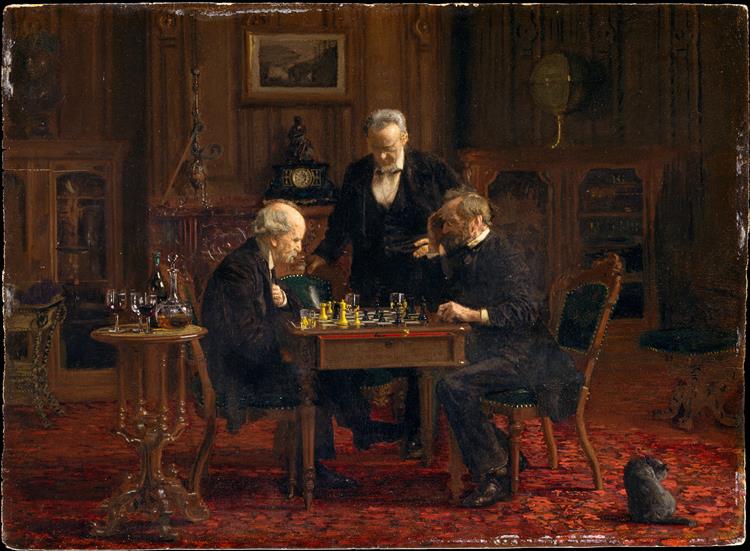Kuvaus
Thomas Eakins' painting "The Chess Player", created in 1876, is a masterful work that embodies the artist's fascination with the depiction of human beings and their interactions within a context of psychological tension and strategy. Eakins, known for his descriptive realism and attention to detail, in this work he manages to reflect the depth of human character through his focus on a simple but complex game of chess.
The composition of the work is remarkable. Eakins presents a single player, an intense-looking man who is immersed in the game. His posture, leaning slightly forward, suggests concentration and deep meditation on his next move, a capture of the moment when the human mind is faced with decisions that are both logical and emotional. Eakins’ choice to focus attention on a single character, as opposed to the more crowded compositions that sometimes characterize the art of his era, allows him to delve deeper into the psychology of the player. The solitary figure is appropriately modeled, reflecting his focus.
The color in “The Chess Player” is predominantly earthy, with a palette that consists of brown and beige tones, contrasting superbly with the dark hues of the background. This color choice not only sets an introspective mood, but also accentuates the seriousness of the game. Shadows play an important role, creating a sense of depth that invites the viewer to share the space and mindset of the player. Eakins uses light masterfully, directing it towards the central figure and creating a halo of attention around the player’s head, symbolizing the clarity of his focus.
Furthermore, the depiction of the chess table is significant. Although the board and pieces are present, for Eakins what is essential is the psychological interaction that the game represents; the pieces are mere actors in an intellectual drama. However, the way the board is set up and the position of the pieces suggest a game in progress, implying that each move is the result of careful and strategic deliberation. This opens a dialogue about the mind and rationality in the work of art.
Eakins' interest in anatomy and the human figure is reflected not only in the depiction of the player, but also in the way the composition invites the viewer to question the nature of the game itself. There is an air of solemnity and reverence to the act of playing chess, which becomes a symbol of human struggle, not only against an opponent, but also against oneself.
The historical and social context of chess during the 19th century also reinforces the meaning of the work. At that time, the game was considered an art of strategy, and iconic players were regarded as respected intellectuals. By depicting a chess player, Eakins captures not only the moment, but also the state of a society that valued intellect, reasoning, and competition as the highest virtues of human beings.
In conclusion, “The Chess Player” is more than a depiction of a seemingly simple activity; it is a profound study of human attention, strategy, and psychology. Through his ability to capture the essence of being human in situations of tension and challenge, Thomas Eakins contributes to the narrative of realist art, offering the viewer both a visual delight and an invitation to reflect on the nature of play and the mind. This work stands as a testament to realism in American art, where sincerity and the search for truth are intertwined on a meaningful canvas.
KUADROS ©, a famous painting on your wall.
Hand-made oil painting reproductions, with the quality of professional artists and the distinctive seal of KUADROS ©.
Painting reproduction service with satisfaction guarantee. If you are not completely satisfied with the replica of your painting, we will refund 100% of your money.

